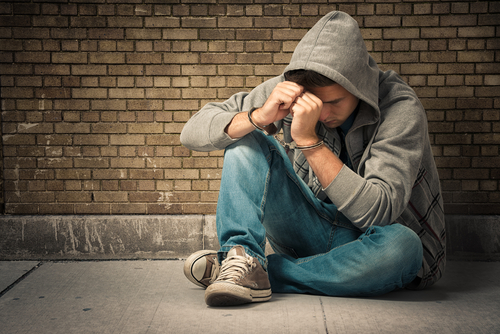This article is written by Priyanshi Soni, from Symbiosis Law School, Noida. This article seeks to highlight the Juvenile Justice System in India and focuses on how juvenile courts function in controlling juvenile delinquency, majorly under the latest Juvenile Justice Act, 2015.
Table of Contents
Introduction
“A child is a person who is going to carry on what you have started. He is going to sit where you are sitting, and when you are gone, attend to those things you think are important. You may adopt all the policies you please, but how they are carried out depends on him. He is going to move in and take over your churches, schools, universities, and corporations. The fate of humanity is in his hands.” – Abraham lincoln
Juvenile delinquency is a rising issue, not only in India but also worldwide. In India, the Juvenile Justice System mainly deals with the children who are in conflict with the law or who are in need of protection and care and provides them with proper care, rehabilitation, correction homes, etc. suiting their best interests. There has always been a presumption that juveniles or children should be dealt with as leniently as possible since either they are incapable of being criminal-minded or even if they are so, it is due to some external influence. However, currently, crimes among juveniles are on the increase.
In this regard, stricter laws are being introduced – the Juvenile Justice Act of 1986 and Juvenile Justice (Care and Protection of Children) Act, 2000 and the latest being the Juvenile Justice (Care and Protection of Children) Act, 2015. We will look into its provisions in detail in the article and will also dive into the new Juvenile Justice Amendment Bill, 2021. Further, the importance and role of juvenile courts in dealing with such juvenile offenders is of great importance as they give us an outlook of how the judicial system works in this regard.
The Juvenile Justice (Care and Protection of Children) Act, 2015 : an overview
The Act was passed in 2015 to include many new provisions keeping in mind the increasing crime rate by children below the age of 18. It mandates the establishment of at least one Juvenile Justice Board and Child Welfare Committee in each district. The Act also focuses on juvenile rehabilitation and care through various correction homes and also contains adoption-related clauses in the better interest of the child.
The definition of a child and juvenile as per the 2015 Act
‘Child’ is defined under the Juvenile Justice Act, 2015 as someone who has not completed 18 years of age (a minor) and it classifies a child in two ways, namely,
- Children in conflict with laws.
- Children in need of care and protection.
‘Juvenile’ is also defined in the same manner as someone who is below 18 years. Thus, this Act removed the negative connotation which was attached to the word ‘Juvenile’. So, a juvenile in conflict with the law is a child who is an offender, and a juvenile in the protection of the law is the abandoned child in need of legal help. This Act includes a provision to deal with offenders between the age of 16 to 18 as adults if they commit a heinous offence. This change was included in the backdrop of the Nirbhaya Gang Rape Case of 2012 wherein one of the offenders was 17 years and few months old but since at that time, there was no such law to, he could not be tried as an adult.
In penal laws, maxim doli incapax is used which means that children are deemed incapable of forming the intent to commit a crime because of their age.
In Satya Deo v. State of Uttar Pradesh (2020), it was held that the child will not be denied his right to be treated as a juvenile at the time of the commission of an offense if he was below 18 years even if the offense took place before the enforcement of the Act of 2000. As per Section 25 of the 2015 Act, the 2000 Act would continue to be applied to cases that were pending before the passage of the 2015 Act.
Amendments proposed in 2021
It was found that 39% of the Child Care Institutions are not registered in 2020, even though the Act of 2015 mandated it. The living conditions were poor with many institutes missing basic facilities such as the presence of a toilet or clean drinking water. This all signalled the need for amendments.
The key amendments are –
- Serious offenses, which are offenses under the Indian Penal Code, 1860 for which the punishment is between 3 to 7 years, will now also include offenses whose punishment is more than 7 years without any minimum period.
- It changes the offenses with a punishment period of 3 to 7 years from being cognizable (arrest without warrant) to non-cognizable.
Further, the Act also amends a few provisions related to adoption and Child Welfare Committees (CWCs) .
Juvenile Courts and their importance in India
The main function of juvenile courts is to have a special and distinctive procedure to look into juvenile offenders. As opposed to what earlier criminal courts used to do, wherein there was no distinction made between juveniles and adults, the juvenile courts in present times give necessary protection to children as they are not in a position to properly defend themselves. The need was realized to make the process more reformative for juveniles rather than punitive.
Juvenile Justice Board is the Juvenile Court created under Section 4 of the Juvenile Justice Act (2015). Criminal justice administration is a state subject as per Schedule VII of the Indian Constitution.
Section 4 of the Act starts with a non-obstante clause i.e. which has an overriding effect over the Code of Criminal Procedure, 1973. This clause was being discussed in the case Chandavarkar Sita Ratna Rao v. Ashalata S. Guram (1987).
It mandates the establishment of at least one Juvenile Justice Board in each district. This board will comprise of a Principal Magistrate and 2 social workers at least one of whom should be a woman. The decision of the Principal Magistrate will be final. This principle is discussed under Section 4(2) of the Act.
In State of Himachal Pradesh v. Happy (2019), the order passed by the Board was held to be void ab initio as the composition requirements were not fulfilled and the verdict was passed by a single member.
Powers and functions of the board
- The Board is empowered to deal with the cases under its jurisdiction and cases dealing with children in conflict with the law.
- The power exercised by the Board can also be exercised by the High Court or the Session Court when the appeals from the Board come to them.
- The Board has the power to inquire into heinous offenses as per Section 15 of the Act and such a preliminary assessment can be disposed of within 3 months of bringing the juvenile in front of the board.
- The Board has to inform the parent or guardian of the child at every step of the process.
- The Board shall ensure that the rights of the child are protected throughout the process of inquiry and rehabilitation and ensuring legal aid for the child.
- The Board shall, whenever necessary, provide the child with a translator if there is difficulty in understanding the language, on payment of fees if required.
- It is the duty of the Board, wherever deemed necessary, to transfer a child in conflict with the law to a committee stating that the child is in need of care.
- It also has a provision regarding filing an First Information Report (FIR) in case of an offense against a child in conflict with the law.
- Periodically conducting inspection of residential facilities for children in conflict with the law and recommending various measures for improvement in the quality of services.
Juvenile delinquency : a rise in the current scenario
Juvenile delinquency involves the involvement of a juvenile in illegal activities or behavior. Delinquency may not always be regarded as criminal activity, but this kind of behavior is harmful to the child himself and to the society.
The crime rate is on an increase in India already, and what we now see is a surge in Juvenile offenders. The biggest example anyone can give of such a heinous offence committed by a juvenile will be that of the Nirbhaya Case of 2012 where the child who committed the heinous crime of rape of the girl in a bus, with others, couldn’t be punished with death sentence or rather couldn’t be tried as an adult although he was 17 years old and even had the right capacity to think about what he was doing. This outraged the people and so the authorities deemed it fit to change the law.
Causes of juvenile delinquency
- Harsh disciplinary measures by parents and even teachers are beyond normal and try to insult children and make them feel worthless without giving a proper reason for their acts. Such acts focus on punitive measures and in no way try to reform the child.
- At times, bad peer company also leads to delinquency in young teenagers. Teenage is such an age where the adolescents usually fall prey to the new things which is most of the time bad and they get a lure to try out things which are meant for adults, such as drinking, smoking, etc. also if the kind of people they hangout is bad, then they might end up committing illegal acts too.
- Attention Deficit Hyperactivity Disorder (ADHD) and various other mental disorders can also be one of the reasons.
- Social factors such as broken homes due to death of one of the parents or divorce of parents, poverty, and beggary constitute some of the reasons for delinquency in children in India.
Evolution of laws related to juvenile delinquency in India
The Apprentices Act of 1850 was the first legislation dealing with juvenile delinquents and according to this, juveniles under the age of 15 who have committed any petty offenses will be bound as apprentices. Then came the Reformatory Schools Act of 1897 which aimed at sending the children to reformatory school. In 1987, the first Juvenile Justice Act came up after independence. The aim was the protection, rehabilitation, and reformation of juvenile delinquents. As per this Act, juveniles were defined as boys under 16 and girls under 18 years of age. But, after the Juvenile Justice Act of 2000, the age for both boys and girls was set to be 18 to be called juveniles. Then came the Juvenile Justice Act of 2015.
International concerns for juveniles
The Convention on the Rights of the Child which was adopted by the UNGA in 1989 focuses on the best interest of the children. The following rights of a child are focused on under this Convention:
- Right of survival, which includes proper standard of living to the children with healthy nutrition and other necessities.
- Right to protection from inhuman practices, trafficking, armed conflicts, etc.,
- Right to participation includes freedom of speech, expression, religion, and opinion and thus ensuring proper participation by them.
- Right to development which includes all kinds of educational, physical, mental, and cultural, and recreational development.
Article 34 of the said Convention protects children from any kind of sexual exploitation or abuse, exploitation through prostitution, and exploitation by using them in pornography.
Article 37 states that imprisonment of a child should be used as a last resort and that too shall be for the shortest possible period. This way it protects the liberty of the children and focuses more on their reformation and development.
Juvenile Justice System in the United Kingdom
The law in the U.K. believes that children should not be prosecuted in criminal courts and for them, delinquency can vanish when they grow up if they are properly reformed in remand homes and for this, only juvenile courts should look into such cases. The Acts such as the Children and Young Offenders Act of 1933 and the Criminal Justice Act of 1948 further implement all these requirements. The 1908 Children Act provides a provision for the creation of a separate judicial board in juvenile courts.
Juvenile Justice System in the United States
The system in the U.S. is more simple. Firstly, the police officer will either keep the child in custody or release him immediately. Then, he will have to inform and hand him over to the juvenile court. After the trial, the children are sent to correction homes and they are tried as adults only in cases where their age is closer to adulthood or when they commit crimes repeatedly which can make them a danger for the whole society.
The International Juvenile Justice Observatory (IJJO)
It is an international organization that aims at promoting the making of policies, rules, legislation for the development and protection of juveniles and these are applicable all over the world. It also provides information regarding the juveniles in the world who are in conflict with the law and are in need of attention.
Recommendations
The Juvenile Justice Act of 2015 brought many good changes in the justice delivery of juveniles, such as proper distinction between the 2 categories of juveniles, formation of a proper Justice Board and added a provision for heinous crimes by juveniles between 16 to 28 years of age which was a great step with the changing needs of the society. But, it has few problems too:
- Age from 16 to 18 is a vulnerable age due to many hormonal and mental imbalances taking place in the body. These usually change when one grows up into an adult. So, if such children are tried as adults, then it can lead to a major impact on their mind and can affect them permanently.
- Also, many have pointed out that this provision of the trial of 16 to 18 years juveniles like an adult is in contravention to Article 14 of the Indian Constitution which ensures equality before the law and the UN Convention on Child Rights.
As we all know, prevention is better than cure. Proper education development and counseling from time to time by parents and at schools can help children in many ways. More focus should be on rehabilitation so that the future of such kids does not get affected by their present deeds and they come out as better beings.
Therefore, for the proper development of a child into a good being, rather than a delinquent, the following things need to be ensured by the government:
- Giving children a basic minimum standard of living with proper focus on education of all and recreation of all.
- As discussed, special training programs should be conducted for children by way of counselling and discussing child psychology with them.
- Proper assistance of a social worker and a lady officer in the child cell should be made compulsory even during investigations who understand child psychology well.
- Police should be more careful about the handling of the juvenile.
- Even the staff of the shelter homes of juveniles should be well trained in dealing with children of such age and such minds.
Apart from this, there should be more public awareness at the end of the general public that such children do exist and that handling them with an open mind is the need of the hour.
Conclusion
Children are undeniably the future of this world. There is a great need for more reformed legislation that aims at deterrence of such juveniles so that their as well as society’s future is secured. This will help make the world a better place and also can reduce the chance of future crimes. Small delinquent acts by children can also have a huge impact on their future, and so, this needs to be tackled at an early stage itself. Above mentioned reforms and counsellings at an early age are very important especially for those who come from a harsh or disturbing background. NGOs need to work equally towards the betterment of children in need.
References
- http://cara.nic.in/PDF/JJ%20act%202015.pdf
- https://www.nolo.com/legal-encyclopedia/juvenile-court-overview-32222.html
- https://www.latestlaws.com/articles/overview-of-juvenile-justice-law-in-india-by-chhaya-khosla/
- http://rajasthanjudicialacademy.nic.in/docs/studyMaterial06112020.pdf
- https://knowlaw.in/index.php/2021/03/17/juvenile-delinquency-a-rising-concern/
- https://www.ohchr.org/en/professionalinterest/pages/crc.aspx
- https://prsindia.org/billtrack/the-juvenile-justice-care-and-protection-of-children-amendment-bill-2021
- http://14.139.60.114:8080/jspui/bitstream/123456789/16815/1/031_Precursors%20of%20Juvenile%20Courts%20in%20India%20%28502-510%29.pdf
- https://indiankanoon.org/
Students of Lawsikho courses regularly produce writing assignments and work on practical exercises as a part of their coursework and develop themselves in real-life practical skills.
LawSikho has created a telegram group for exchanging legal knowledge, referrals, and various opportunities. You can click on this link and join:
https://t.me/joinchat/J_0YrBa4IBSHdpuTfQO_sA
Follow us on Instagram and subscribe to our YouTube channel for more amazing legal content.
 Serato DJ Crack 2025Serato DJ PRO Crack
Serato DJ Crack 2025Serato DJ PRO Crack











 Allow notifications
Allow notifications



